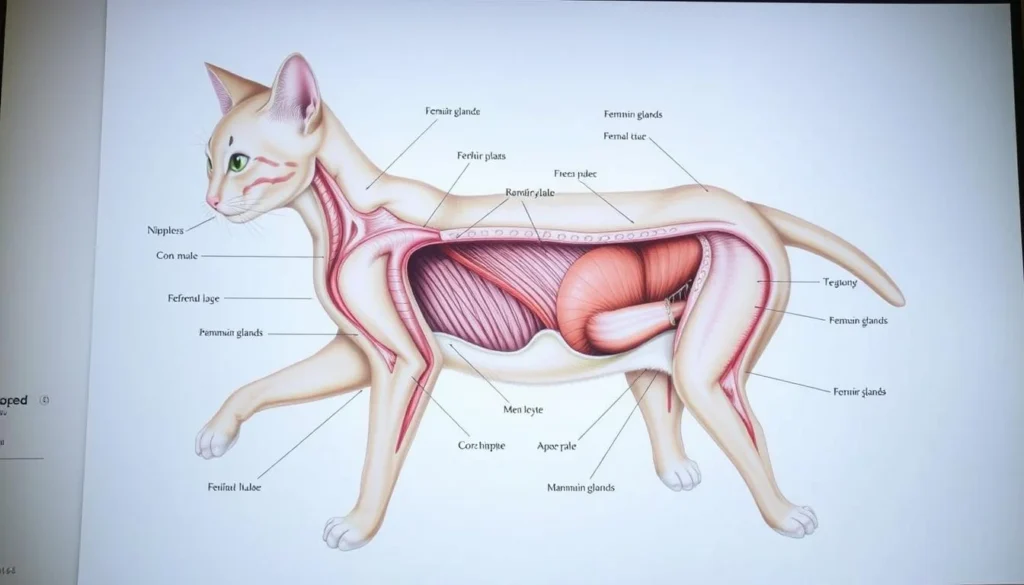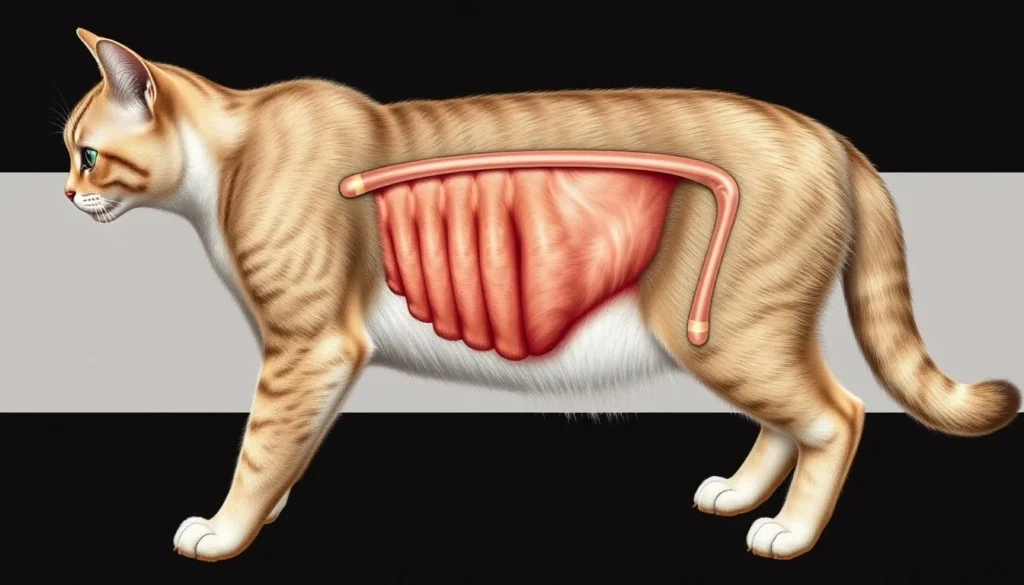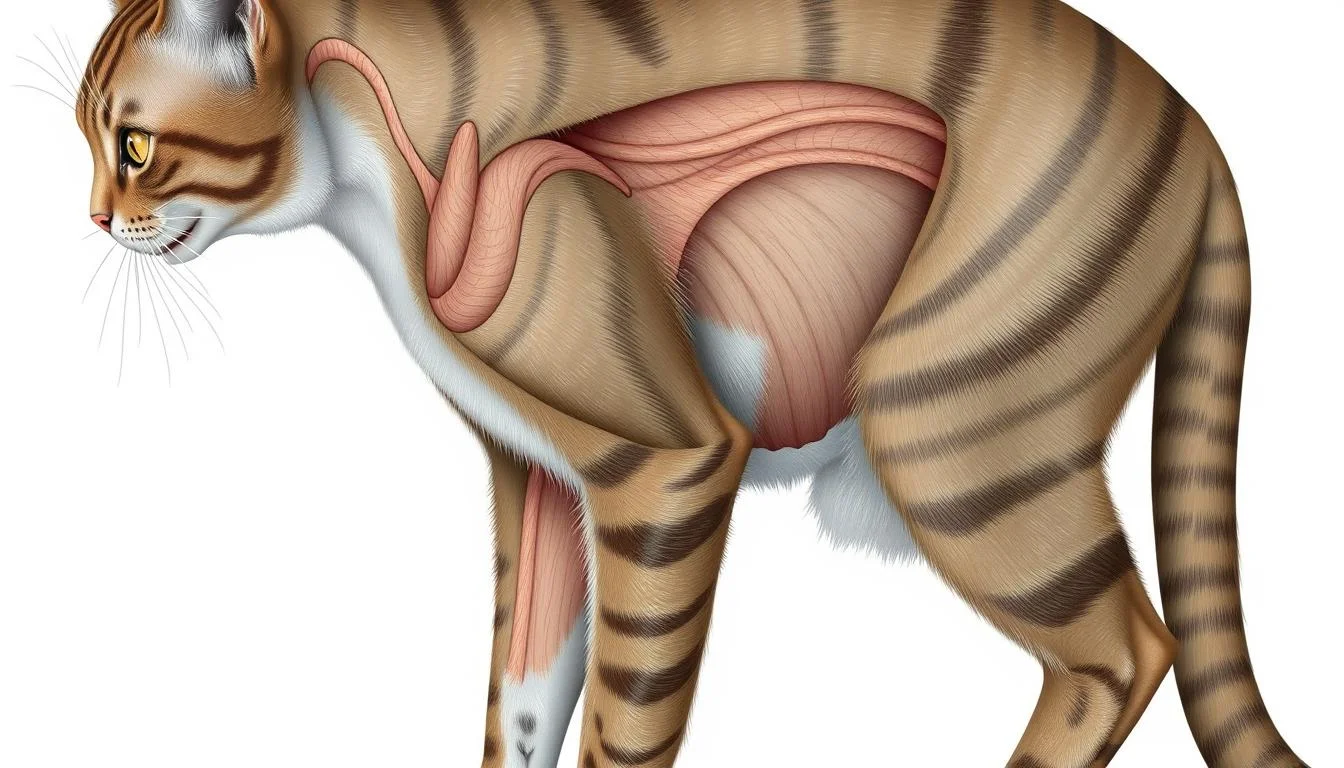Table of Contents
Ever wondered about the mysterious world of male cat anatomy? You’re not alone. The question of whether male cats have nipples might seem strange. But it’s a fascinating aspect of feline biology that many pet owners overlook.
Male cat anatomy is more complex than you might imagine. Nipples play an intriguing role in understanding their biological development.
When it comes to do male cats have nipples, the answer might surprise you. Both male and female cats are born with nipples. They usually have six to eight of them arranged in pairs along their bellies.
These small, often unnoticed features are a testament to the complex process of embryonic development in feline anatomy.
Understanding your cat’s body can help you become a more informed and attentive pet owner. From genetic inheritance to biological quirks, the presence of nipples in male cats reveals fascinating insights into mammalian development. These insights go far beyond what meets the eye.
Key Takeaways
- Male cats have nipples, just like female cats
- Cats typically have 6 to 8 nipples in paired rows
- Nipples develop before sexual differentiation occurs
- These nipples remain non-functional in male cats
- Feline nipple anatomy is a result of early embryonic development
Understanding Basic Feline Mammary Anatomy
Exploring cat anatomy shows us how fascinating mammary glands and nipples are. They tell us a lot about how cats grow and reproduce. Your cat’s nipples are more complex than they seem at first.

Cats have a special nipple setup that can vary. Most have six to eight nipples, in pairs on their belly. This pattern is key for nursing and reproduction.
Location and Number of Cat Nipples
Knowing where cat nipples are helps us understand them better. Here’s what you need to know:
- They’re in two rows from chest to lower abdomen.
- Most have six to eight nipples.
- But, some cats might have four to ten nipples.
- Both males and females have them symmetrically.
Structure of Mammary Glands
Cat mammary glands are complex for milk production. Female cats have fully developed glands. Male cats have less developed tissue.
Biological Development in the Womb
Nipples start forming before a cat’s gender is known. This is why both males and females have nipples, no matter their reproductive roles.
“Nature’s design ensures nipple development occurs early in fetal growth, independent of future reproductive roles.”
Knowing about your cat’s nipples, whether male or female, gives us a peek into their biology.
Do Male Cats Have Nipples: The Complete Answer

Ever wondered about tomcat nipples? You’re not alone. Yes, male cats do have nipples. These small features are a key part of feline anatomy that surprises many cat owners.
Male cats usually have 6 to 8 nipples. They are found in two rows on their belly and chest. These nipples are there from birth and stay throughout their lives, even though they can’t produce milk.
“Nature doesn’t always follow our expectations of functionality,” explains veterinary specialist Dr. Anna Roberts.
The reason male cats have nipples is their early development. In the beginning, all kittens grow the same way before they start to show gender differences. This means both male and female kittens start out with the same body plan.
- Male cats have nipples just like female cats
- Nipples develop before gender characteristics emerge
- Each cat typically has 6-8 nipples
- Nipples are non-functional in male cats
Some cats might have supernumerary nipples – extra nipples on their sides. This is normal and doesn’t mean they’re sick.
Even though male cats can’t make milk, their nipples show how complex and interesting life development is.
The Evolutionary Purpose Behind Male Cat Nipples
Male cat nipples are a mystery that offers deep insights into cat biology and reproduction. Nature’s way of developing embryos is fascinating. It shows why male cats have these seemingly useless features.
At the start, all mammalian fetuses look very similar. This is because they all begin with the same basic body plan. It’s only later, with hormonal changes, that they start to show their gender.
Embryonic Development Process
The early stages of a cat’s development are filled with complex genetics. Nipples start to form before the cat’s sex is determined. This means male and female embryos look the same at first.
- Nipples form during the first weeks of embryonic growth
- Hormonal signals determine gender-specific characteristics later
- Male cat biology retains these early developmental markers
Genetic Inheritance Patterns
Genetics are key to understanding why male cats keep their nipples. These nipples are leftovers from evolution. They have no use in male cats today.
“In nature, efficiency does not always mean complete elimination of seemingly unnecessary features.” – Veterinary Embryology Research
Over time, cat reproduction has kept these traits alive. This shows how genetics and development work together. Male cat nipples may not serve a purpose, but they highlight the complex process of mammalian development.
Physical Characteristics of Male Cat Nipples
Understanding male cat nipples can make you appreciate your cat more. Male cats have small, hidden nipples under their fur.
Tomcat nipples have some key traits:
- Located in symmetrical rows along the abdomen
- Usually four to six pairs in total
- Consistently small and uniform in size
- Firmly attached to underlying muscle tissue
These nipples stay the same size throughout a male cat’s life. Unlike female cat nipples, they don’t grow or change. They are a sign of early development in both male and female cats.
Nature’s blueprint ensures male cats carry these vestigial anatomical features as a reminder of shared developmental pathways.
Some male cats might have different numbers of nipples. While most have four to six pairs, you might see cats with fewer or more. These differences are normal and usually don’t mean anything bad.
Your male cat’s nipples are just a sign of early development. They show how complex mammalian development is.
Comparing Male and Female Cat Nipples
Exploring the differences between male and female cat nipples offers interesting insights into cat anatomy. Both male and female cats have nipples, but they serve different purposes.
Cat nipples share some common traits, but their development and function vary greatly. Almost all mammals have nipples, and cats are no exception.
Size and Appearance Differences
Feline nipples show unique differences between males and females:
- Male cats usually have 6 to 8 nipples in pairs on their belly
- Female nipples grow bigger and more noticeable during pregnancy and nursing
- Female nipples become larger and more prominent during lactation
- Male nipples stay about the same size their whole life
Functional Distinctions
The main difference is in how these nipples are used. Female cats use theirs to nurse kittens. Male nipples, on the other hand, don’t have a direct function. Interestingly, male cat mammary cancer is very rare, showing how little male nipples are used.
Nature’s design ensures that even though male cat nipples serve no direct purpose, they remain a testament to early embryonic development.
Newborn kittens have very similar mammary structures, showing no difference until they develop sexually.
Health Concerns Related to Male Cat Nipples
Male cat anatomy might seem simple, but nipples can hint at health problems. Knowing about feline nipple health is key to keeping your cat safe.
Male cats, even without nursing kittens, can face nipple health issues. It’s wise to have your vet check their nipples regularly.
- Look out for odd signs like:
- Redness or swelling
- Unexpected discharge
- Texture changes in the area
Some serious conditions can affect male cat nipples. Mammary gland tumors are rare but need quick medical care.
“Early detection is key to managing nipple health issues in cats.” – Veterinary Specialists
Genetics can play a role in nipple health. Some cats have extra nipples due to polythelia. While usually safe, any big changes should be checked by a vet.
- Important tips for keeping nipples healthy:
- Get annual vet check-ups
- Keep an eye on nipple changes
- Tell your vet about any odd signs
Being watchful can help your cat stay healthy and catch problems early.
Common Myths About Male Cat Nipples Debunked
Many pet owners are confused about male cat biology, including nipples. Knowing the truth about male cat nipples can clear up myths and misconceptions.
Let’s look at some common myths about male cat nipples and separate fact from fiction:
- Myth: Only female cats have nipples
Reality: Both male and female cats have nipples from the start. This is true for all cats.
- Myth: Male cat nipples serve no purpose
Studies show that male cat nipples are left over from early development. They show what the fetus was meant to be before it became a male cat.
- Myth: Nipples on male cats indicate a health problem
Vets say that male cat nipples are normal. They don’t mean there’s a health issue.
Cultural Misconceptions
Different cultures have their own views on male cat anatomy. Some believe male cat nipples mean something special, but these ideas aren’t supported by science.
Scientific Facts vs. Popular Beliefs
“In male cat biology, nipples are a natural anatomical feature, not a biological anomaly.” – Veterinary Research Journal
Learning about the science behind male cat nipples helps owners see they’re just a normal part of a cat’s development. There’s no need to worry about them.
When to Be Concerned About Changes in Male Cat Nipples
Knowing about male cat anatomy is key. It helps you spot health issues with their nipples. Male cats have nipples, but changes can mean serious health problems.
Look out for these warning signs in your cat’s nipple health:
- Unexpected swelling or enlargement
- Unusual discoloration
- Discharge or fluid leakage
- Visible skin changes around nipple areas
- Signs of pain when touched
Regular home checks are important for spotting health issues early. When you groom your cat, gently feel around the nipples. Any unusual texture or changes need a vet’s check.
“Early detection of changes in feline nipples can prevent serious health complications.” – Veterinary Health Experts
Some serious conditions include mammary tumors, infections, or hormonal imbalances. Even though male cats can’t make milk, their nipples can get sick. This needs vet care.
Not all changes are bad, but a vet can help keep your cat healthy. Trust your gut and get vet advice if you see anything odd with your cat’s nipples.
The Role of Hormones in Feline Nipple Development
Exploring male cat biology shows us how nipples develop. Hormones are key from the start of growth in the womb.
Hormones shape nipples in both male and female cats during reproduction. Testosterone is important here. It stops mammary tissue from growing in males after birth.
Nature’s blueprint ensures that nipples remain present but non-functional in male cats.
The journey of feline nipple development has many stages:
- Embryonic hormone interactions determine initial nipple formation
- Testosterone limits mammary tissue growth in male cats
- Genetic programming maintains nipple structures across genders
At first, male and female cat embryos have the same nipple structures. Hormonal signals then guide their development apart. Females keep functional mammary tissue, while males have non-working nipples.
As they grow, hormonal changes happen again. Male cats usually become sexually mature between five to seven months. These changes affect their body development.
Male cat nipples may not work, but they show us the complex world of cat reproduction.
Conclusion
Looking into whether male cats have nipples opens up interesting facts about their bodies. It shows how much we can learn about cats beyond just their looks. Male cats grow nipples early in their development, showing how their bodies are shaped by genes.
Every cat is different, and this is true for their nipples too. Most male cats have six nipples, but some might have more or less. This shows how unique each cat is, with its own special features.
It’s important to take your cat to the vet regularly. Watching for any changes in their nipples can help spot health problems early. By knowing about cat bodies and watching your cat closely, you help keep them healthy.
Learning about male cats and their nipples is more than just a fun fact. It’s a way to understand the amazing world of animals. Your interest and care can greatly improve your cat’s life, showing that knowing is key to being a good pet owner.
